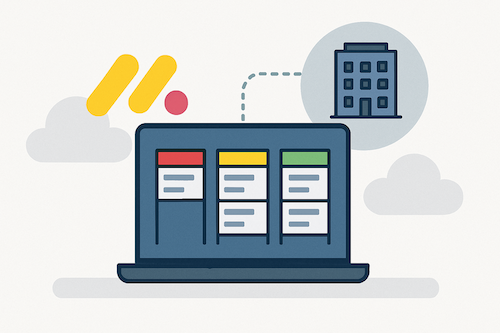
Table of Contents
The way we organize work is constantly shifting, isn’t it? We’ve seen a fascinating evolution from rigid, monolithic systems to more agile, user-centric platforms. Into this dynamic landscape steps Monday.com, a platform that has rapidly gained traction, positioning itself as a Work Operating System (Work OS). But what does this mean for established enterprise environments, often navigating a complex web of legacy and modern applications? My observations, drawn from tracking numerous system deployments, suggest its impact is noteworthy, though not without its nuances.
Understanding Monday.com’s Appeal
Monday.com’s appeal is immediately understandable. Its visual interface, drag-and-drop functionality, and extensive customization options offer a breath of fresh air for teams tired of clunky, unintuitive software. This ease of use can unlock significant productivity gains, particularly for project management, task tracking, and cross-departmental collaboration. Insights distilled from evaluating various productivity tools indicate that platforms empowering end-users to design their own workflows tend to see rapid adoption. They can feel like a genuine step towards democratizing process improvement.
The Enterprise Integration Question
However, a perspective forged through years of navigating real-world enterprise integrations prompts a deeper look. While Monday.com excels in flexibility, how does this translate when scaled across a large organization with stringent governance and data security requirements? This is where the conversation gets interesting. Can a tool celebrated for its adaptability truly coexist with, and even enhance, the more structured (and often less malleable) core systems like ERPs and CRMs?
Bridging Operational Gaps: A Niche for Work OS
Monday.com is effectively carving out a powerful niche in bridging operational gaps. Many organizations grapple with processes that don’t quite fit neatly into their primary enterprise applications. These might be unique departmental workflows, ad-hoc project needs, or collaborative initiatives that require a level of agility that core systems simply can’t provide. Here, a Work OS can act as a connecting tissue, bringing a degree of order and visibility to these otherwise fragmented activities. I’ve seen scenarios where such platforms effectively streamline handoffs between, say, a sales team using a CRM and an operations team managing fulfillment through an ERP, by providing a shared, transparent layer for project status.
The Strategic Imperative: Governance and Integration
The strategic challenge, then, isn’t just about adopting Monday.com; it’s about thoughtfully integrating its capabilities. Without a clear governance framework, the very flexibility that makes it attractive can lead to data silos or inconsistent process management (a sort of digital “shadow IT” but with prettier dashboards). It’s crucial to define where it fits, what data it should manage, and how it interacts with systems of record. This requires a proactive approach, something I’ve often seen as a critical success factor in technology adoption. Organizations that anticipate these integration points and establish clear guidelines are far more likely to harness the platform’s full potential.
Technical Integration Architecture
Implementing Monday.com within established enterprise architectures requires careful consideration of data flow patterns and system boundaries. API-first integration becomes essential, leveraging Monday.com’s robust REST API to create bidirectional data flows with core business systems. This approach enables real-time synchronization of project data, resource allocation, and status updates across the enterprise ecosystem.
Webhook-based event streaming provides another powerful integration pattern, allowing Monday.com to trigger automated workflows in downstream systems when project milestones are reached or resource assignments change. This event-driven approach reduces manual data entry while maintaining system coupling at appropriate levels.
Data Architecture Considerations
Enterprise deployments must address data ownership and lineage questions proactively. Master Data Management (MDM) principles become critical when determining which systems serve as authoritative sources for customer data, project definitions, and resource information. Monday.com should complement, not duplicate, these authoritative sources.
Data governance policies must explicitly define Monday.com’s role in the enterprise data landscape. This includes establishing clear protocols for data retention, access controls, and audit trails. Organizations often implement a federated governance model where business units maintain autonomy over their workflow configurations while adhering to enterprise-wide data standards.
Security and Compliance Framework
Enterprise adoption requires addressing security and compliance requirements that extend beyond Monday.com’s standard offerings. Single Sign-On (SSO) integration becomes mandatory, typically through SAML or OAuth protocols that align with existing identity management systems.
Role-based access control (RBAC) must map to existing organizational hierarchies and project structures. This often requires implementing custom permission schemes that reflect complex matrix organizations and project governance requirements.
Future Outlook: Agility Meets Control
Looking ahead, the role of platforms like Monday.com within the enterprise seems set to grow, especially as businesses increasingly favor composable architectures. Their ability to offer customizable, quickly deployable solutions for specific operational needs is a compelling proposition. The key will be to balance this newfound agility with the enduring need for enterprise-grade control and cohesion. It’s a balancing act, for sure, but one that successful organizations are learning to master.
What are your thoughts on the evolving role of Work OS platforms in the enterprise? I’d be interested to hear your perspectives. Connect with me on LinkedIn.